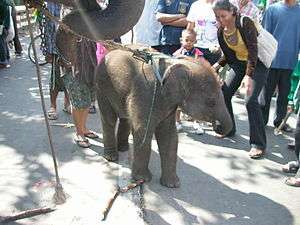Elephant crushing

Elephant crushing, or a training crush is a method by which wild elephants can be tamed for domestication, using restriction in a cage, sometimes with the use of corporal punishment or negative reinforcement. This practice is condemned by a variety of animal welfare groups as a form of animal cruelty.
The training crush
As reported in the UN Report Gone Astray, in India, Myanmar and Thailand the 'kraal' or ‘training crush’ method involves an elephant being placed in a strong, large stall or cage and tied with ropes to keep the elephant from moving, including being unable to kick, raise or swing its head. This method is supposed to crush the elephant's spirit. Proponents argue that this allows the elephant to properly and safely learn the basic command “Still!” or “Quiet!”, and enable it to adapt to its new environment.
National Geographic reports on the use of nails and sticks stabbed into the ears and feet of an elephant the subject of a crush in Thailand. Other reports cite the use of beatings with sticks, chains or bullhooks, sleep-deprivation, hunger, and thirst to "break" the elephant and make them submissive to their owners. It is not clear whether all training crushes involve the use of corporal punishment.
Quoted in Gone Astray, a 1967 report on a training crush notes, 'An elephant born in captivity is brought up amongst human beings and its training is humane from the day it begins; but a wild beast parted from the herd and its mother must suffer agonies before its will is broken.'
Thailand
.jpg)
Working and performing elephants in Thailand are often poached from Myanmar and trafficked into Thailand.[1] There are around 6,500 elephants currently living in Thailand, with around 2,500 of them being caught from the wild. Trafficked animals can be passed off as being locally reared, with birth and ownership documentation falsified.[1]
Baby elephants are taken from the wild, with the adult elephants around the baby killed.[1] The elephants are then often put through a process of beatings to "mentally break" them (the so-called "phajaan"), to make them submissive for the lucrative entertainment of tourists in tourist parks.[1]
Animal welfare advocates have called for better legislation and systems to document the origin of elephants in tourist camps and other locations across Thailand.[1]
Alternatives
Zoos, including those in countries such as the USA, used corporal punishment and negative reinforcement to train elephants until the mid-1970s. A new technique, called protected contact or non-dominance is used in modern zoos. The new training uses rewards, not punishment to encourage the behavior of the animal to the target behavior.
Another alternative is to use Trained elephants (called Kumkis in India) - to tame / train / chase wild elephants. This practice is widely used in countries such as India.
References
External links
- Activists Denounce Thailand's Elephant "Crushing" Ritual, Jennifer Hile, National Geographic Today, October 16, 2002
- Elephant Abuse Charges Add Fuel to Circus Debate, Maryann Mott, National Geographic News, 6 April 2004
- Gone Astray - The Care and Management of the Asian Elephant in Domesticity Richard C Lair, Food And Agriculture Organization Of The United Nations (FAO), October 1997, ISBN 974-89472-3-8